A clamp meter is an essential tool for anyone working with electrical systems, offering a quick and safe way to measure current without the need to disconnect wires. By simply clamping the meter around a conductor, you can measure the flow of electricity without interrupting the circuit, making it perfect for troubleshooting and routine maintenance. Clamp meters are often used by electricians, HVAC professionals, and DIYers to check current levels in homes, businesses, and industrial settings.
Beyond measuring current, many clamp meters also offer additional functions, such as measuring voltage, resistance, and continuity, adding to their versatility. With digital displays, compact designs, and advanced features like data hold and auto-ranging, clamp meters provide accurate, real-time readings with ease.
If you’re looking for a reliable tool to diagnose electrical issues and ensure safe operation, a clamp meter is an indispensable device that simplifies the process of electrical testing.
Our Top Clamp Meter Picks
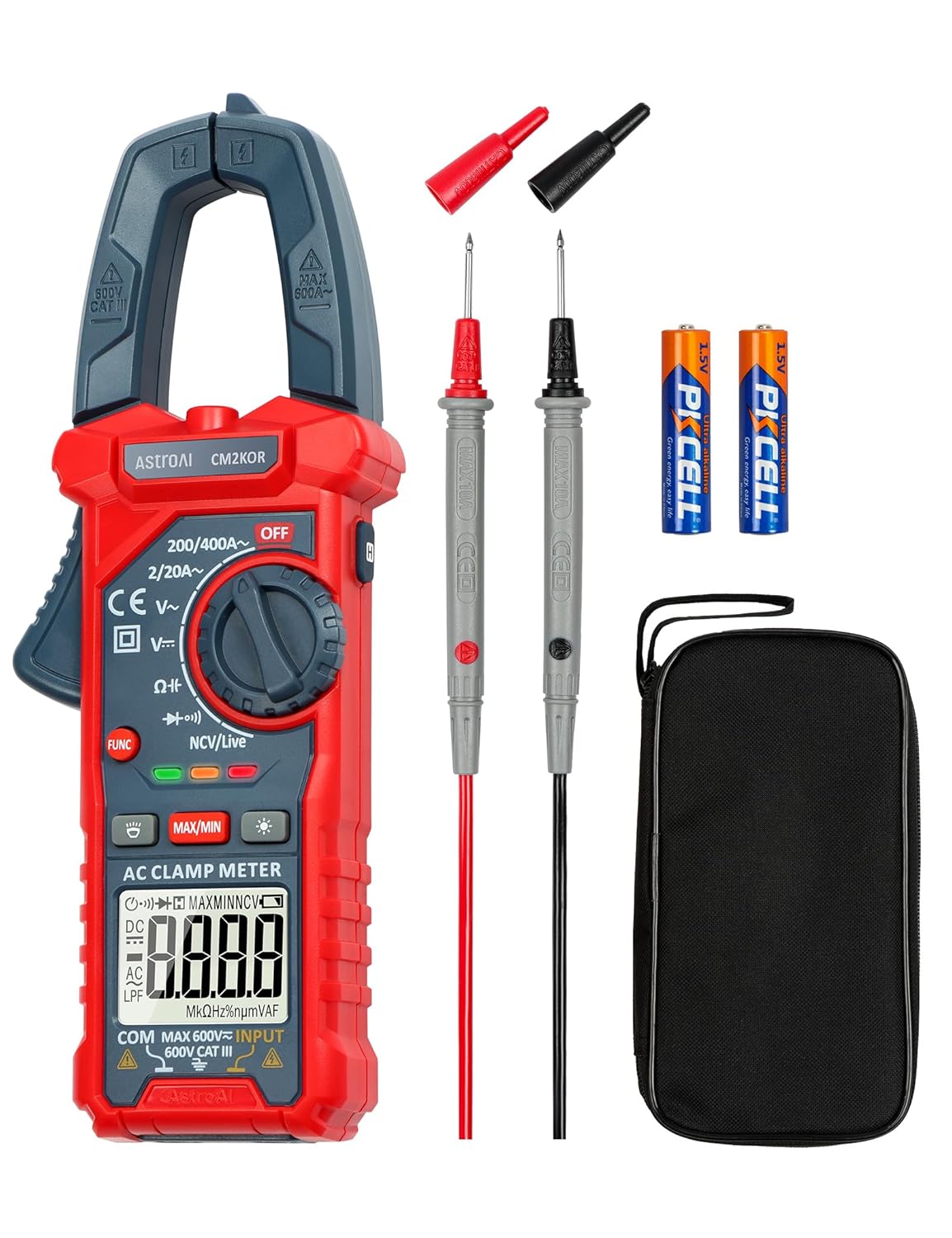
AstroAI Digital Clamp Meter Multimeter
Check on AmazonKey Specs
- Measurement Range: AC Current, AC/DC Voltage, Capacitance, Resistance, Diode Continuity
- Jaw Opening: Large enough for easy measurements without interrupting the circuit
- Display: Backlit LCD screen with visual and audio alerts
- Power Source: Battery-powered (2 x 1.5V AAA batteries included)
- Safety Standards: Passed environmental pollution degree 2 and overvoltage category III 600V
The AstroAI Digital Clamp Meter is an excellent tool for those dealing with electrical systems, offering versatility and ease of use. It can accurately measure AC current, AC/DC voltage, capacitance, resistance, diode continuity, and live wire tests. The large jaw opening allows for safe, non-invasive measurements, and the slim design is perfect for tight spaces. With features like data hold, max/min, auto shut-off, and a backlit LCD display, it’s a reliable choice for both industrial and household electrical troubleshooting.
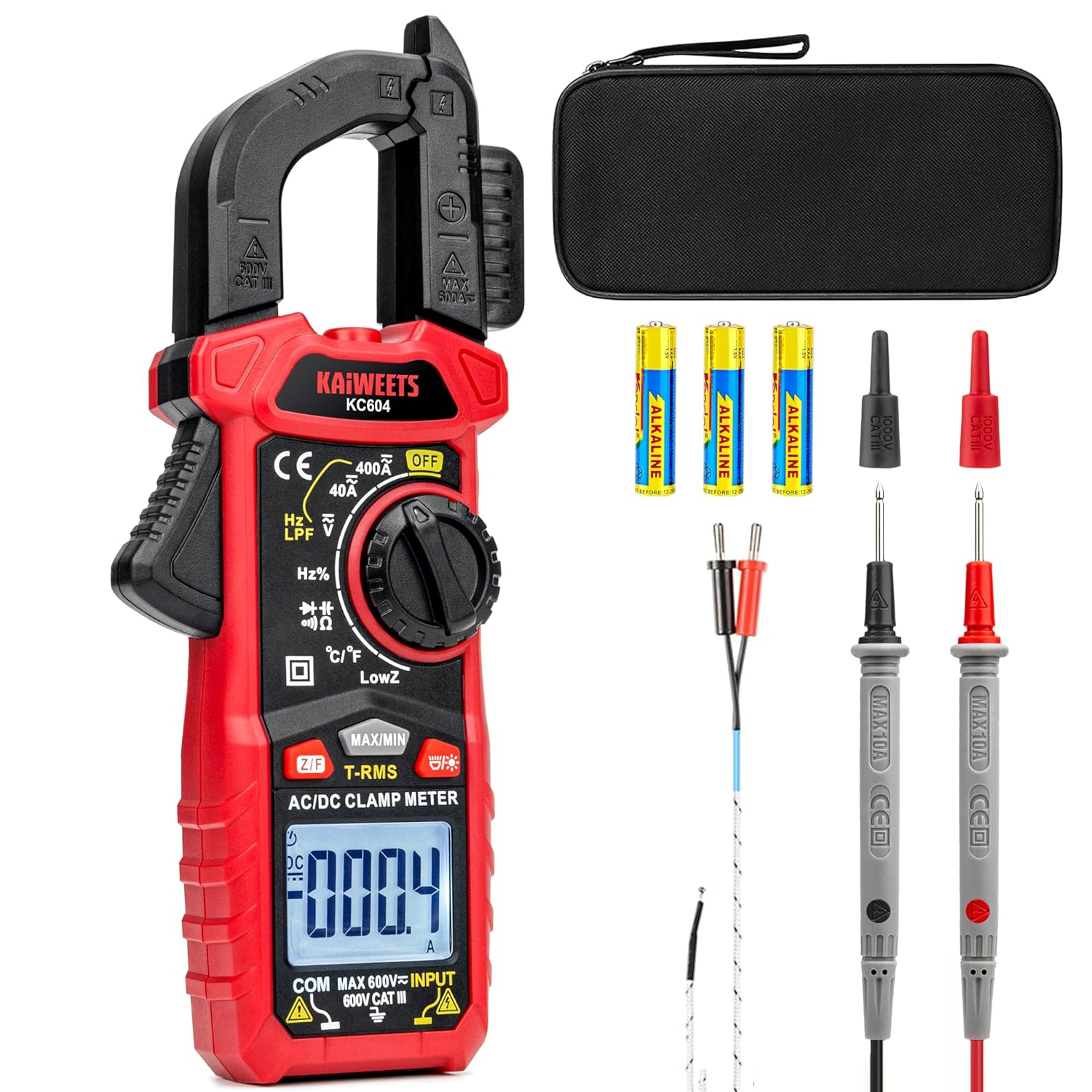
KAIWEETS Digital Clamp Meter
Check on Amazon
Key Specs:
- Measurement Range: AC/DC current, voltage, temperature, capacitance, frequency, resistance
- Jaw Design: D-shaped jaw with 1.1-inch opening
- Non-Contact Voltage (NCV): Detects AC voltage with audible and visual alerts
- Display: LCD backlight with flashlight for clear readings in low-light conditions
- Safety: Passed IEC61010-1 and CAT III 600V certification, automatic shutdown after 15 minutes
The KAIWEETS Digital Clamp Meter is a versatile and reliable tool, perfect for professionals and DIY enthusiasts. This multimeter can measure AC/DC current and voltage, temperature, capacitance, frequency, resistance, continuity, and diode, making it ideal for a variety of electrical applications. Its unique D-shaped jaw opens up to 1.1 inches, allowing easy access to cables. With features like non-contact voltage detection, backlit display, and automatic shutdown, it’s designed for both safety and convenience.
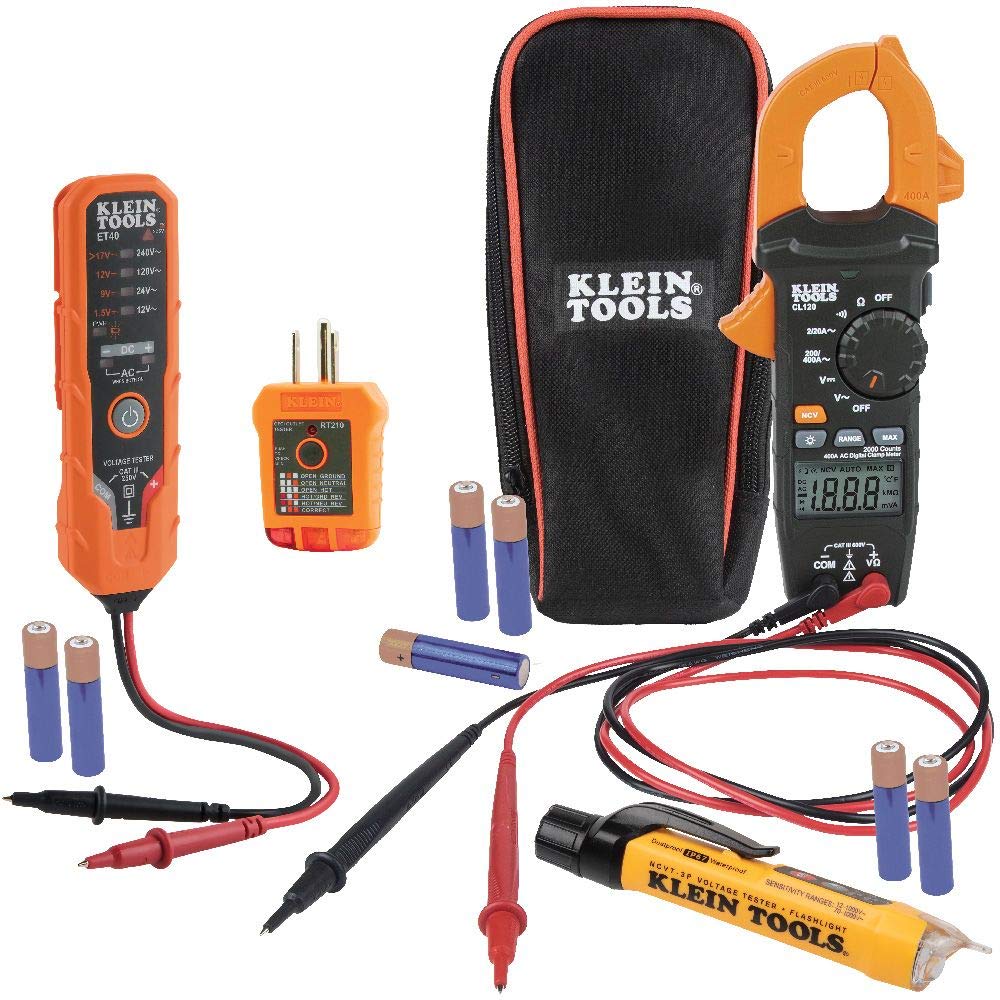
Klein Tools CL120VP
Check on Amazon
Key Specs:
- Measurement Range: AC current (clamp), AC/DC voltage, resistance, continuity (test leads)
- Features: Auto-ranging, test lead holder, optional magnetic hanger
- Additional Tools: GFCI tester (RT210), non-contact voltage detector (NCVT3P), voltage tester (ET40)
- Built-in Flashlight: For better visibility in low-light conditions
- Safety: Dual-range voltage detection for various applications
The Klein Tools CL120VP Clamp Meter Kit is a versatile and practical tool designed for a variety of electrical applications. It measures AC current via the clamp, and AC/DC voltage, resistance, and continuity via test leads. The auto-ranging technology ensures accurate results by automatically selecting the appropriate range. The kit also includes a GFCI receptacle tester, non-contact voltage detector, and a voltage tester. For added convenience, a test lead holder and a built-in flashlight make it easier to work in low-light conditions.
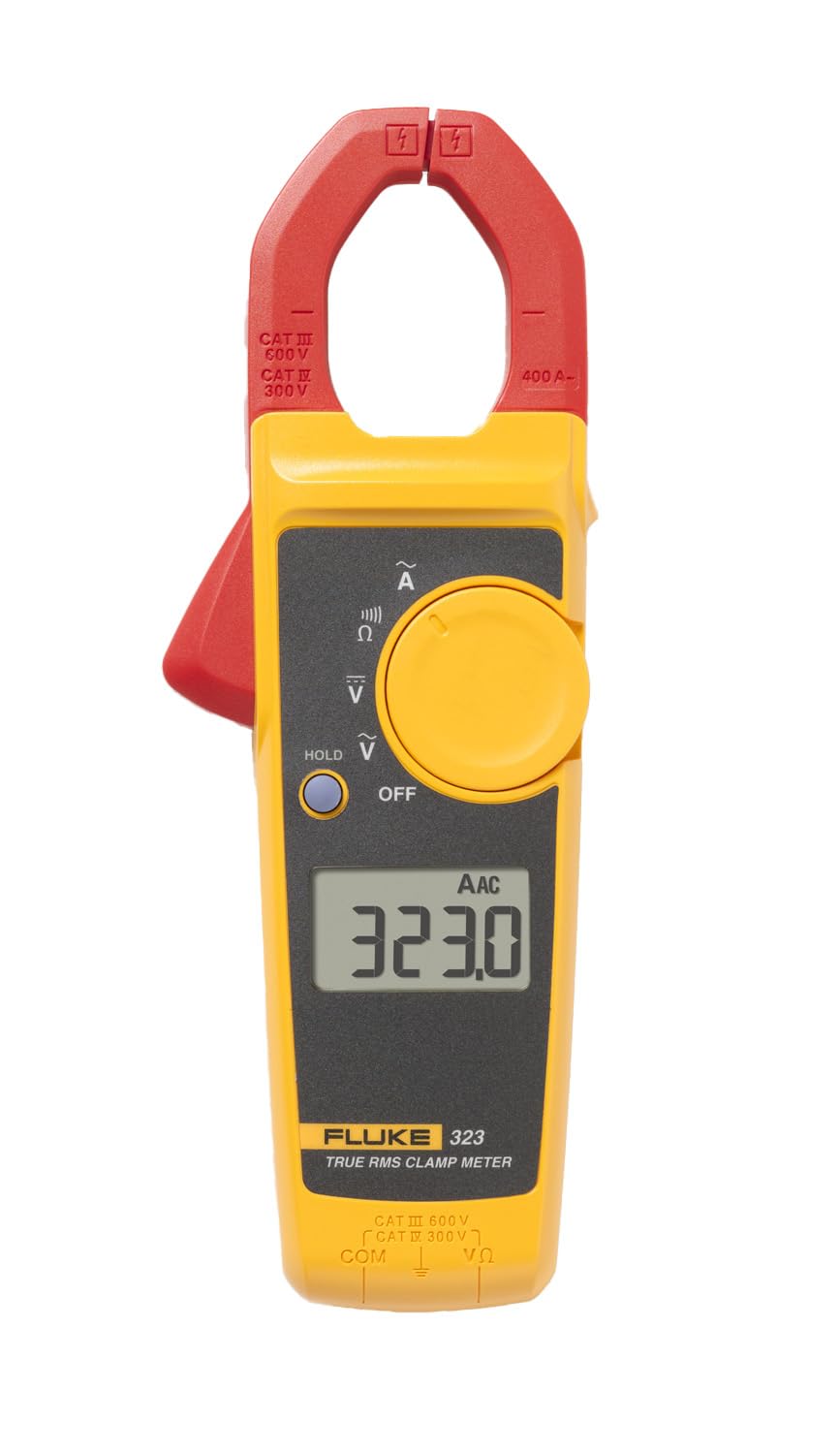
Fluke 323 Clamp Meter
Check on Amazon
Key Specs:
- Current Measurement: AC up to 400A
- Voltage Measurement: AC/DC up to 600V
- Resistance Measurement: Up to 4 kilo ohms
- Jaw Opening: Measures conductors up to 30 millimeters
- Safety Rating: CAT IV 300V, CAT III 600V
The Fluke 323 Clamp Meter is a highly reliable tool for measuring AC current, AC/DC voltage, and resistance, specifically designed for professionals in electrical testing. With a jaw opening of up to 30 millimeters, it can measure current without direct contact, making it incredibly safe and convenient. The true RMS sensing feature ensures accurate readings for both linear and non-linear loads. It also includes an audible continuity sensor and meets IEC safety standards, making it ideal for a range of electrical applications.
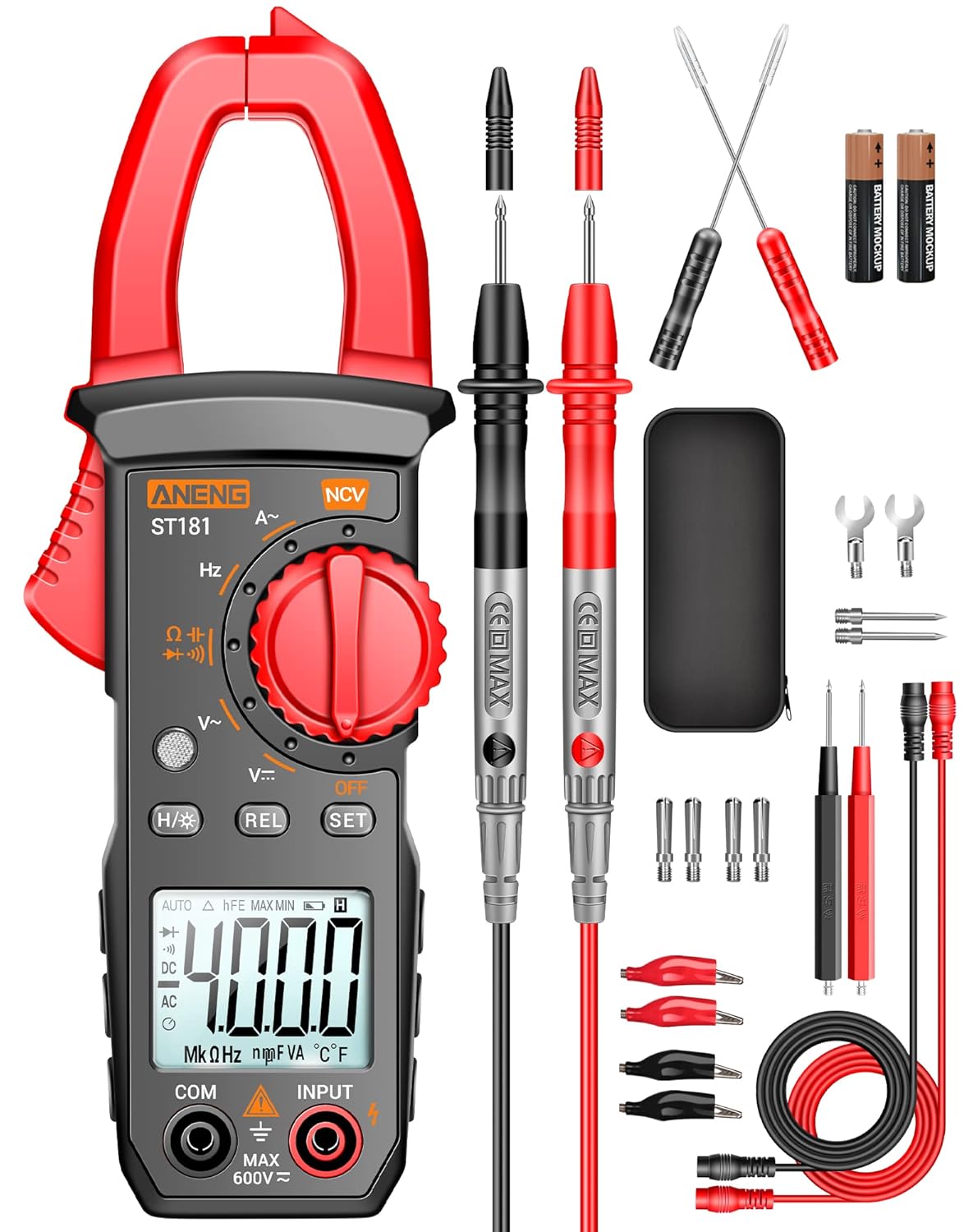
ANENG Digital Clamp Meter
Check on AmazonKey Specs:
- Power Source: Battery powered (2 x AAA batteries)
- Measurement Functions: AC current, AC/DC voltage, resistance, capacitance, continuity, diode, frequency, NCV
- Jaw Opening: 1.42 inches (maximum wire diameter)
- Includes: Multimeter, test leads, alligator clips, PVC cables, copper needles, U-shaped insert
- Warranty/Support: Includes technical support and service
The ANENG Digital Clamp Meter is a versatile and reliable tool, ideal for troubleshooting electrical issues with its wide range of measurement capabilities. It can measure AC voltage, AC current, resistance, capacitance, continuity, diode testing, and even frequency (Hz), making it a valuable device for both professionals and DIY enthusiasts. The double-open clamp design allows easy access to wires up to 1.42 inches in diameter, while the non-contact voltage (NCV) function ensures safe and quick voltage detection. Its lightweight design and protective exterior make it easy to carry and use for long workdays.
Definition of a Clamp Meter
A clamp meter, also known as a clamp-on ammeter, is a versatile and indispensable tool in the field of electrical work. It is a handheld device used to measure current in a conductor without needing to make physical contact or disconnect the circuit. The clamp meter gets its name from its design, which features a hinged “clamp” jaw integrated into an electrical meter.
This tool allows electricians to bypass the traditional method of cutting into a wire to measure current. Instead, the clamp meter uses the magnetic field created by the current flowing through the conductor to give an accurate reading. This non-invasive method of measurement is not only safer but also more convenient.
Clamp meters come in a variety of sizes and shapes, with different specifications and features. They can measure other parameters such as voltage, resistance, and continuity, making them a multifunctional tool for electrical professionals.
Importance of a Clamp Meter in Electrical Work
In the realm of electrical work, safety, accuracy, and efficiency are paramount. A clamp meter is a tool that embodies these three principles. By allowing current measurements without contact, it significantly reduces the risk of electrical shock and short circuits. This is particularly important when dealing with high voltage systems or complex electrical installations.
Accuracy is another crucial aspect of electrical work. Incorrect readings can lead to faulty installations, equipment failures, and even dangerous situations. Clamp meters are known for their precise measurements, which help ensure that electrical systems are functioning correctly and safely.
Lastly, the efficiency offered by clamp meters cannot be overstated. Traditional methods of measuring current can be time-consuming and cumbersome, requiring the circuit to be turned off and the wire to be cut. With a clamp meter, an electrician can simply clamp the device onto a conductor and get an immediate reading, saving valuable time and effort.
Understanding the Basics of a Clamp Meter
How a Clamp Meter Works
The operation of a clamp meter revolves around the principles of electromagnetic induction. When current passes through a conductor, it generates a magnetic field around it. The clamp meter’s jaws, when clamped around the conductor, detect this magnetic field. The meter then uses this information to calculate and display the current flowing through the conductor.
It’s important to note that the clamp meter must encircle the conductor completely for an accurate reading. If the jaws do not fully close, the magnetic field will not be properly detected, leading to inaccurate results. Also, the meter can only measure the current of one conductor at a time. If multiple conductors are enclosed within the jaws, the readings will be off.
While the basic function of a clamp meter is to measure current, many modern devices come with additional features. These can include the ability to measure voltage, resistance, and continuity, as well as advanced functions like data logging and true RMS (Root Mean Square) measurement.
Different Types of Clamp Meters
There are two main types of clamp meters: current transformer clamp meters and Hall Effect clamp meters. Current transformer clamp meters are the most common type and are used primarily for AC current measurements. They operate on the principle of electromagnetic induction, as described above.
Hall Effect clamp meters, on the other hand, can measure both AC and DC currents. They use a Hall Effect sensor, a device that produces a voltage proportional to the magnetic field’s strength and direction. This makes them more versatile than current transformer clamp meters, but also more expensive.
Aside from these two types, there are also specialized clamp meters designed for specific applications. For example, some clamp meters are designed for high current measurements, while others are made for low current (or “leakage”) measurements. Choosing the right type of clamp meter depends on the specific needs and requirements of the user.
Factors to Consider When Buying a Clamp Meter
Accuracy of the Meter
Accuracy is a critical factor when choosing a clamp meter. A meter’s accuracy is usually expressed as a percentage of the reading plus a fixed number of digits. For example, a meter with an accuracy of ±(2% + 5) means that the reading can be off by 2% of the actual value plus or minus 5 counts. It’s important to choose a meter with an accuracy that is suitable for the intended application.
Keep in mind that accuracy can vary depending on the range of measurement. Some meters may be more accurate at certain ranges than others. Also, factors like temperature, humidity, and battery condition can affect a meter’s accuracy. Always refer to the manufacturer’s specifications for detailed information on accuracy.
For professional electricians and technicians, a high degree of accuracy is often necessary. However, for DIY enthusiasts or homeowners who just need a basic tool for simple electrical tasks, a slightly lower accuracy may be acceptable.
Range of Measurements
The range of measurements refers to the minimum and maximum values that a clamp meter can measure. This includes current, voltage, resistance, and other parameters. It’s important to choose a meter that can handle the range of measurements required for your tasks.
For example, if you need to measure high currents, you should choose a meter with a high current range. On the other hand, if you need to measure low currents or “leakage” currents, you should choose a meter with a low current range. Some meters also have an “auto-range” feature, which automatically selects the appropriate range based on the input.
Keep in mind that the range of measurements can also affect the meter’s accuracy. Generally, a meter is most accurate in the middle of its range. As the measurement approaches the minimum or maximum of the range, the accuracy may decrease.
Safety Features
Safety is paramount when dealing with electricity. Therefore, it’s important to choose a clamp meter with adequate safety features. One of the most important safety features is the meter’s category rating, also known as the CAT rating. This rating indicates the maximum voltage that the meter can safely handle.
CAT ratings are divided into four categories: CAT I, CAT II, CAT III, and CAT IV. CAT I is for low-voltage applications like electronic devices, while CAT IV is for high-voltage applications like utility service equipment. Always choose a meter with a CAT rating that is suitable for your tasks.
Other safety features to look for include input protection, overload protection, and a sturdy, insulated design. Some meters also have a “hold” function, which allows you to take a reading and then remove the meter from the circuit for safer viewing.
Ease of Use
The ease of use of a clamp meter is another important factor to consider. A good clamp meter should be easy to operate, even for beginners. This includes a clear, easy-to-read display, intuitive controls, and a comfortable grip.
The display should be large enough to read easily, with a backlight for working in low-light conditions. The controls should be clearly labeled and easy to navigate. Some meters also have a “one-touch” operation, which allows you to take a measurement with a single press of a button.
The design of the meter should also be ergonomic, with a comfortable grip and a lightweight construction. This is especially important for professionals who use the meter for extended periods. A good clamp meter should also be compact and portable, making it easy to carry and store.
Durability and Build Quality
The durability and build quality of a clamp meter are crucial factors to consider, especially for professionals who use the meter regularly. A good clamp meter should be built to last, with a sturdy construction and high-quality materials.
The meter should be able to withstand the rigors of daily use, including drops, knocks, and exposure to dust and moisture. Some meters are even rated for water and dust resistance, with IP (Ingress Protection) ratings. An IP rating of IP54, for example, indicates that the meter is protected against dust and splashing water.
The quality of the clamp jaws is also important. They should be strong and durable, with a smooth opening and closing mechanism. The jaws should also be well-insulated to prevent accidental contact with live conductors.
Brand Reputation and Reviews
When buying a clamp meter, it’s important to consider the reputation of the brand and the reviews of the product. A reputable brand is more likely to produce high-quality, reliable products. They are also more likely to offer good customer service and support, including warranty and repair services.
Product reviews can provide valuable insights into the performance and reliability of a clamp meter. Look for reviews from users who have similar needs and requirements as you. Pay attention to their comments on the meter’s accuracy, ease of use, durability, and other factors.
However, be wary of overly positive or negative reviews, as they may not be entirely truthful. Always consider multiple reviews and sources of information before making a decision.
Price and Value for Money
The price of a clamp meter can vary widely, depending on the brand, features, and specifications. While it’s important to stay within your budget, it’s also important to consider the value for money of the meter.
A cheap clamp meter may seem like a good deal, but it may not be accurate, durable, or safe enough for your needs. On the other hand, an expensive clamp meter may have features and specifications that you don’t really need. Therefore, it’s important to choose a meter that offers the best balance of price, performance, and features for your needs.
When comparing prices, also consider the cost of accessories and consumables, like batteries and probes. Some meters come with these included, while others do not. Also, consider the cost of calibration and repair services, as these can add to the total cost of ownership.
Detailed Review of Top Clamp Meters in the Market
Fluke 323 True-RMS Clamp Meter
The Fluke 323 True-RMS Clamp Meter is a professional-grade tool known for its accuracy, reliability, and durability. It is designed to perform in the toughest environments and provide noise-free, reliable results. With its True-RMS technology, it can accurately measure both sinusoidal and non-sinusoidal waveforms, making it suitable for commercial and industrial applications.
The Fluke 323 has a wide measurement range, capable of measuring up to 400 A AC current, 600 V AC/DC voltage, and 4 kΩ resistance with continuity detection. It also has a slim, ergonomic design that makes it easy to handle and use, even in tight spaces. The large, backlit display is easy to read, even in low-light conditions.
Despite its advanced features, the Fluke 323 is easy to use, with a simple, intuitive interface. It also has a robust construction, with a sturdy case and durable clamp jaws. With its reputation for quality and performance, the Fluke 323 offers excellent value for money.
Klein Tools CL800 Digital Clamp Meter
The Klein Tools CL800 Digital Clamp Meter is a versatile tool that offers a wide range of measurements. It can measure AC/DC voltage, AC/DC current, resistance, continuity, frequency, duty-cycle, capacitance, and even temperature. This makes it a truly multifunctional tool, suitable for a variety of electrical tasks.
The CL800 features True-RMS technology for accurate measurement of non-linear loads. It also has an auto-ranging feature, which automatically selects the appropriate range based on the input. This makes it easier to use and reduces the risk of incorrect readings.
The design of the CL800 is user-friendly, with a large, backlit display and clearly labeled controls. The clamp jaws are wide and sturdy, capable of clamping around large conductors. The meter is also built to last, with a rugged, impact-resistant case and a CAT IV safety rating.
Etekcity MSR-C600 Digital Clamp Meter
The Etekcity MSR-C600 Digital Clamp Meter is a budget-friendly option that offers good performance and features for its price. It can measure AC/DC voltage, AC current, and resistance, with a maximum range of 600 V and 400 A. It also has a continuity test function, which can detect closed circuits and continuity problems.
The MSR-C600 features an auto-ranging function, which automatically selects the appropriate range for the measurement. This simplifies operation and ensures accurate readings. The meter also has a data hold function, which allows you to take a reading and then remove the meter from the circuit for safer viewing.
The design of the MSR-C600 is compact and portable, making it easy to carry and store. The display is large and clear, with a backlight for working in low-light conditions. The meter also has a robust construction, with a durable case and sturdy clamp jaws.
Amprobe AMP-210 Clamp Meter
The Amprobe AMP-210 Clamp Meter is a professional-grade tool designed for accuracy and reliability. It features True-RMS technology for accurate measurement of non-linear loads, and a wide measurement range for AC/DC voltage, AC current, resistance, and frequency.
The AMP-210 has a number of advanced features, including a low-pass filter for accurate measurement of variable frequency drives, and a non-contact voltage detection function for safer operation. It also has a large, backlit display and a rotary dial for easy selection of functions.
The design of the AMP-210 is ergonomic and durable, with a comfortable grip and a rugged, drop-resistant case. The clamp jaws are wide and sturdy, capable of clamping around large conductors. With its combination of performance, features, and durability, the AMP-210 offers excellent value for money.
How to Use a Clamp Meter Safely and Effectively
Basic Steps in Using a Clamp Meter
Using a clamp meter is relatively straightforward, but it’s important to follow the correct steps to ensure accurate readings and safe operation. Here are the basic steps in using a clamp meter:
1. First, turn on the meter and select the function you want to measure (e.g., current, voltage, resistance).
2. If the meter has a range selection, choose the appropriate range for your measurement. If the meter has an auto-range function, it will automatically select the range for you.
3. Open the clamp jaws and place them around the conductor you want to measure. Make sure the jaws fully enclose the conductor and are not touching any other conductors or objects.
4. Read the measurement on the display. If the meter has a data hold function, you can press the hold button to freeze the reading on the display.
5. When you’re done, remove the meter from the conductor and turn it off. Always remember to store the meter in a safe, dry place when not in use.
Safety Precautions When Using a Clamp Meter
While a clamp meter is a safe tool to use, it’s important to follow certain safety precautions to avoid accidents and injuries. Here are some safety tips when using a clamp meter:
1. Always check the meter’s CAT rating and make sure it is suitable for the voltage level of the circuit you’re working on. Never use a meter on a circuit with a higher voltage than the meter’s rating.
2. Inspect the meter before use. Check for any signs of damage or wear, such as cracked casing, loose parts, or frayed wires. If the meter is damaged, do not use it.
3. Do not touch the conductor or any other live parts with your hands or any part of your body. Always use the meter’s clamp jaws to make contact with the conductor.
4. Do not use the meter in wet or damp conditions, unless it is specifically rated for such use. Moisture can cause electric shock and damage the meter.
5. Always remove the meter from the circuit before changing functions or ranges. This will prevent incorrect readings and potential damage to the meter.
Troubleshooting Common Issues
Like any tool, a clamp meter can sometimes encounter issues that affect its performance and accuracy. Here are some common issues and how to troubleshoot them:
1. Inaccurate readings: This can be caused by a number of factors, such as incorrect range selection, poor contact with the conductor, or interference from other magnetic fields. Check your range selection and make sure the clamp jaws are fully enclosing the conductor. If the problem persists, try using the meter in a different location to avoid interference.
2. No readings: This could be due to a dead battery, a blown fuse, or a faulty meter. Check the battery and replace it if necessary. If the meter has a fuse, check it and replace it if it’s blown. If the meter is still not working, it may be faulty and need repair or replacement.
3. Erratic readings: This could be caused by a weak battery, interference from other magnetic fields, or a faulty meter. Replace the battery if it’s weak. Try using the meter in a different location to avoid interference. If the readings are still erratic, the meter may be faulty and need repair or replacement.
Maintaining Your Clamp Meter for Longevity
Proper Storage and Handling
Proper storage and handling are crucial for maintaining the longevity of your clamp meter. Here are some tips for storing and handling your meter:
1. Always store the meter in a clean, dry place. Avoid exposing it to extreme temperatures, humidity, or direct sunlight.
2. Keep the meter in its protective case when not in use. This will protect it from dust, moisture, and physical damage.
3. Handle the meter with care. Avoid dropping it or knocking it against hard surfaces. Do not force the clamp jaws open or closed, as this can damage the mechanism.
4. Keep the meter clean. Wipe it with a soft, dry cloth after use. Do not use abrasive cleaners or solvents, as these can damage the meter’s casing and display.
Regular Calibration and Cleaning
Regular calibration and cleaning are important for maintaining the accuracy and performance of your clamp meter. Here are some tips for calibrating and cleaning your meter:
1. Have the meter calibrated regularly by a qualified technician. The frequency of calibration depends on the manufacturer’s recommendations and the intensity of use. As a general rule, most meters should be calibrated at least once a year.
2. Clean the meter regularly to remove dust, dirt, and grime. Use a soft, dry cloth to wipe the casing and display. For the clamp jaws, use a soft brush to remove any debris. Do not use water or solvents, as these can damage the meter.
3. Check the battery regularly and replace it if it’s weak. A weak battery can cause inaccurate readings and poor performance. Always use the type of battery recommended by the manufacturer.
When to Seek Professional Help for Repairs
If your clamp meter is not working properly, it’s important to seek professional help for repairs. Here are some signs that your meter needs professional repair:
1. The meter is not turning on, even with a new battery.
2. The meter is giving inaccurate or erratic readings, even after calibration.
3. The meter is physically damaged, such as a cracked casing, loose parts, or frayed wires.
4. The meter’s functions or features are not working properly, such as the backlight, hold function, or auto-ranging function.
Remember, attempting to repair a clamp meter yourself can be dangerous and may void the warranty. Always seek professional help for repairs.
Conclusion
Recap of the Importance of Choosing the Right Clamp Meter
Choosing the right clamp meter is crucial for accurate and safe electrical work. The right meter can provide accurate measurements, reduce the risk of electrical shock, and improve efficiency. It’s important to consider factors like accuracy, range of measurements, safety features, ease of use, durability, brand reputation, and price when choosing a clamp meter.
There are many different types of clamp meters on the market, each with its own features and specifications. Some of the top clamp meters include the Fluke 323 True-RMS Clamp Meter, the Klein
